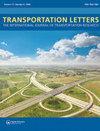Exploring differences in injury severity between occupant groups involved in fatal rear-end crashes: a correlated random parameter logit model with mean heterogeneity
IF 3.3
3区 工程技术
Q2 TRANSPORTATION
Transportation Letters-The International Journal of Transportation Research
Pub Date : 2024-11-25
DOI:10.1080/19427867.2023.2292859
引用次数: 0
Abstract
Rear-end crashes are one of the most common crash types. Passenger cars involved in rear-end crashes frequently produce severe outcomes. However, no study investigated the differences in the injury severity of occupant groups when cars are involved as following and leading vehicles in rear-end crashes. Therefore, the focus of this investigation is to compare the key factors affecting the injury severity between the front- and rear-car occupant groups in rear-end crashes. First, data is extracted from the Fatality Analysis Reporting System (FARS) for two types of rear-end crashes, including passenger cars as rear-end and rear-ended vehicles. Significant injury severity difference between front- and rear-car occupant groups is found by conducting likelihood ratio test. Moreover, the front- and rear-car occupant groups are modeled by the correlated random parameter logit model with heterogeneity in means (CRPLHM) and the random parameter logit model with heterogeneity in means (RPLHM), respectively. This study provides an insightful knowledge of mechanism of occupant injury severity in rear-end crashes.
探索致命追尾碰撞事故中不同乘员组别受伤严重程度的差异:具有均值异质性的相关随机参数 logit 模型
追尾事故是最常见的事故类型之一。发生追尾事故的乘用车经常会产生严重的后果。然而,没有研究调查损伤的差异……
本文章由计算机程序翻译,如有差异,请以英文原文为准。
求助全文
约1分钟内获得全文
求助全文
来源期刊

Transportation Letters-The International Journal of Transportation Research
TRANSPORTATION SCIENCE & TECHNOLOGY-
CiteScore
6.40
自引率
14.30%
发文量
79
审稿时长
>12 weeks
期刊介绍:
Transportation Letters: The International Journal of Transportation Research is a quarterly journal that publishes high-quality peer-reviewed and mini-review papers as well as technical notes and book reviews on the state-of-the-art in transportation research.
The focus of Transportation Letters is on analytical and empirical findings, methodological papers, and theoretical and conceptual insights across all areas of research. Review resource papers that merge descriptions of the state-of-the-art with innovative and new methodological, theoretical, and conceptual insights spanning all areas of transportation research are invited and of particular interest.
 求助内容:
求助内容: 应助结果提醒方式:
应助结果提醒方式:


